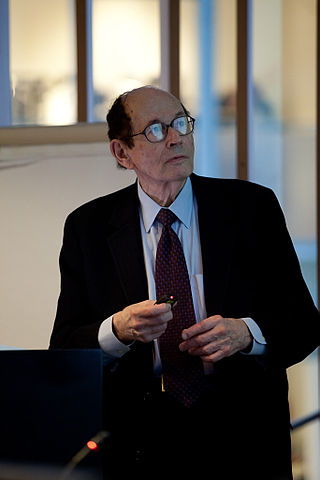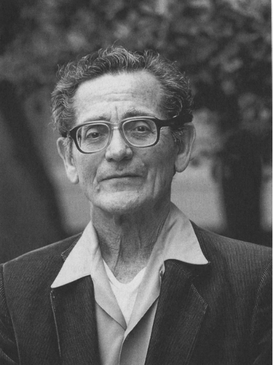Related Research Articles

Consciousness, at its simplest, is awareness of internal and external existence. However, its nature has led to millennia of analyzes, explanations and debates by philosophers, theologians, linguists, and scientists. Opinions differ about what exactly needs to be studied or even considered consciousness. In some explanations, it is synonymous with the mind, and at other times, an aspect of mind. In the past, it was one's "inner life", the world of introspection, of private thought, imagination and volition. Today, it often includes any kind of cognition, experience, feeling or perception. It may be awareness, awareness of awareness, or self-awareness either continuously changing or not. The disparate range of research, notions and speculations raises a curiosity about whether the right questions are being asked.
A lucid dream is a type of dream in which the dreamer becomes aware that they are dreaming while dreaming. During a lucid dream, the dreamer may gain some amount of control over the dream characters, narrative, or environment. Lucid dreaming has been studied and reported for many years. Prominent figures from ancient to modern times have been fascinated by lucid dreams and have sought ways to better understand their causes and purpose.

Neural Darwinism is a biological, and more specifically Darwinian and selectionist, approach to understanding global brain function, originally proposed by American biologist, researcher and Nobel-Prize recipient Gerald Maurice Edelman. Edelman's 1987 book Neural Darwinism introduced the public to the theory of neuronal group selection (TNGS) – which is the core theory underlying Edelman's explanation of global brain function.
An altered state of consciousness (ASC), also called altered state of mind or mind alteration, is any condition which is significantly different from a normal waking state. By 1892, the expression was in use in relation to hypnosis, though there is an ongoing debate as to whether hypnosis is to be identified as an ASC according to its modern definition. The next retrievable instance, by Max Mailhouse from his 1904 presentation to conference, however, is unequivocally identified as such, as it was in relation to epilepsy, and is still used today. In academia, the expression was used as early as 1966 by Arnold M. Ludwig and brought into common usage from 1969 by Charles Tart. It describes induced changes in one's mental state, almost always temporary. A synonymous phrase is "altered state of awareness".
In philosophy and psychology, awareness is a concept about knowing, perceiving and being cognizant of events. Another definition describes it as a state wherein a subject is aware of some information when that information is directly available to bring to bear in the direction of a wide range of behavioral actions. The concept is often synonymous to consciousness and is also understood as being consciousness itself.
A Universe of Consciousness: How Matter Becomes Imagination is the title of a 2000 book by biologists Gerald Maurice Edelman and Giulio Tononi; published in UK as Consciousness: How Matter Becomes Imagination. This book, written with Giulio Tononi, is the culmination of a series of works by Gerald Edelman on the workings of the brain which include Neural Darwinism and Bright Air, Brilliant Fire.
Global Workspace Theory (GWT) is a framework for thinking about consciousness proposed by psychologists Bernard Baars and Stan Franklin in the late 1980s. It was developed to qualitatively account for a large set of matched pairs of conscious and unconscious processes. GWT has been influential in modeling consciousness and higher-order cognition as emerging from competition and integrated flows of information across widespread, parallel neural processes.

Benjamin Libet was an American neuroscientist who was a pioneer in the field of human consciousness. Libet was a researcher in the physiology department of the University of California, San Francisco. In 2003, he was the first recipient of the Virtual Nobel Prize in Psychology from the University of Klagenfurt, "for his pioneering achievements in the experimental investigation of consciousness, initiation of action, and free will".

Neural binding is the neuroscientific aspect of what is commonly known as the binding problem: the interdisciplinary difficulty of creating a comprehensive and verifiable model for the unity of consciousness. "Binding" refers to the integration of highly diverse neural information in the forming of one's cohesive experience. The neural binding hypothesis states that neural signals are paired through synchronized oscillations of neuronal activity that combine and recombine to allow for a wide variety of responses to context-dependent stimuli. These dynamic neural networks are thought to account for the flexibility and nuanced response of the brain to various situations. The coupling of these networks is transient, on the order of milliseconds, and allows for rapid activity.
Focal seizures are seizures which affect initially only one hemisphere of the brain. The brain is divided into two hemispheres, each consisting of four lobes – the frontal, temporal, parietal and occipital lobes. A focal seizure is generated in and affects just one part of the brain – a whole hemisphere or part of a lobe. Symptoms will vary according to where the seizure occurs. When seizures occur in the frontal lobe the patient may experience a wave-like sensation in the head. When seizures occur in the temporal lobe, a feeling of déjà vu may be experienced. When seizures are localized to the parietal lobe, a numbness or tingling may occur. With seizures occurring in the occipital lobe, visual disturbances or hallucinations have been reported.
Hypnopompia is the state of consciousness leading out of sleep, a term coined by the psychical researcher Frederic Myers. Its mirror is the hypnagogic state at sleep onset; though often conflated, the two states are not identical and have a different phenomenological character. Hypnopompic and hypnagogic hallucinations are frequently accompanied by sleep paralysis, which is a state wherein one is consciously aware of one's surroundings but unable to move or speak.

Animal consciousness, or animal awareness, is the quality or state of self-awareness within a non-human animal, or of being aware of an external object or something within itself. In humans, consciousness has been defined as: sentience, awareness, subjectivity, qualia, the ability to experience or to feel, wakefulness, having a sense of selfhood, and the executive control system of the mind. Despite the difficulty in definition, many philosophers believe there is a broadly shared underlying intuition about what consciousness is.

The neural correlates of consciousness (NCC) refer to the relationships between mental states and neural states and constitute the minimal set of neuronal events and mechanisms sufficient for a specific conscious percept. Neuroscientists use empirical approaches to discover neural correlates of subjective phenomena; that is, neural changes which necessarily and regularly correlate with a specific experience. The set should be minimal because, under the materialist assumption that the brain is sufficient to give rise to any given conscious experience, the question is which of its components are necessary to produce it.
The sense of agency (SA), or sense of control, is the subjective awareness of initiating, executing, and controlling one's own volitional actions in the world. It is the pre-reflective awareness or implicit sense that it is I who is executing bodily movement(s) or thinking thoughts. In non-pathological experience, the SA is tightly integrated with one's "sense of ownership" (SO), which is the pre-reflective awareness or implicit sense that one is the owner of an action, movement or thought. If someone else were to move your arm you would certainly have sensed that it were your arm that moved and thus a sense of ownership (SO) for that movement. However, you would not have felt that you were the author of the movement; you would not have a sense of agency (SA).
Homeostatic feeling is a class of feelings that inform us about our physiological condition. In his earlier work Antonio Damasio used "primordial feeling" but he now prefers the term "homeostatic feeling" for the class: "Homeostatic feelings are feelings such as hunger, thirst, pain, desire, wellbeing, as well as the continuous feelings of life itself."
Secondary consciousness is an individual's accessibility to their history and plans. The ability allows its possessors to go beyond the limits of the remembered present of primary consciousness. Primary consciousness can be defined as simple awareness that includes perception and emotion. As such, it is ascribed to most animals. By contrast, secondary consciousness depends on and includes such features as self-reflective awareness, abstract thinking, volition and metacognition. The term was coined by Gerald Edelman.
The activation-synthesis hypothesis, proposed by Harvard University psychiatrists John Allan Hobson and Robert McCarley, is a neurobiological theory of dreams first published in the American Journal of Psychiatry in December 1977. The differences in neuronal activity of the brainstem during waking and REM sleep were observed, and the hypothesis proposes that dreams result from brain activation during REM sleep. Since then, the hypothesis has undergone an evolution as technology and experimental equipment has become more precise. Currently, a three-dimensional model called AIM Model, described below, is used to determine the different states of the brain over the course of the day and night. The AIM Model introduces a new hypothesis that primary consciousness is an important building block on which secondary consciousness is constructed.
Antti Revonsuo is a Finnish cognitive neuroscientist, psychologist, and philosopher of mind. His work seeks to understand consciousness as a biological phenomenon. He is one of a small number of philosophers running their own laboratories.

Consciousness and the Brain: Deciphering How the Brain Codes Our Thoughts is a 2014 book by Stanislas Dehaene. It summarizes research on the neuroscience of consciousness, particularly from recent decades.
Dream consciousness is a term defined by the theorist of dreaming science J. Allan Hobson, M.D. as the memory of subjective awareness during sleep.
References
- 1 2 3 4 Edelman, G. (2004). Wider than the sky: The phenomenal gift of consciousness: Yale Univ Pr.
- 1 2 3 Johanson, M., Revonsuo, A., Chaplin, J., & Wedlund, J.-E. (2003). Level and contents of consciousness in connection with partial epileptic seizures. Epilepsy & Behavior, 4(3), 279–285.
- ↑ Edelman, G. (2003). Naturalizing consciousness: a theoretical framework. Proceedings of the National Academy of Sciences, 100(9), 5520.
- 1 2 3 Merker, B. (2007). Consciousness without a cerebral cortex: A challenge for neuroscience and medicine. Behavioral and Brain Sciences, 30(01), 63–81.
- 1 2 3 4 Seth, A. K., & Baars, B. J. (2005). Neural Darwinism and consciousness. Consciousness and Cognition, 14(1), 140–168.
- 1 2 3 Morin, A. (2006). Levels of consciousness and self-awareness: A comparison and integration of various neurocognitive views. Consciousness and Cognition, 15(2), 358–371.
- 1 2 3 4 Seth, A. K. (2008). Theories and measures of consciousness develop together. Consciousness and Cognition, 17(3), 986–988.
- 1 2 3 Seth, A. K., Dienes, Z., Cleeremans, A., Overgaard, M., & Pessoa, L. (2008). Measuring consciousness: relating behavioural and neurophysiological approaches. Trends in Cognitive Sciences, 12(8), 314–321.
- ↑ Seth, A. (2009). Explanatory Correlates of Consciousness: Theoretical and Computational Challenges. Cognitive Computation, 1(1), 50–63.
- ↑ Edelman, G. (2001). Consciousness: the remembered present. Annals of the New York Academy of Sciences, 929, 111–122.
- 1 2 3 Hobson, A. (2009). The neurobiology of consciousness: Lucid dreaming wakes up. International Journal of Dream Research, 2(2), 41–44.
- 1 2 3 Denton, D., Shade, R., Zamarippa, F., Egan, G., Blair-West, J., McKinley, M., et al. (1999). Neuroimaging of genesis and satiation of thirst and an interoceptor-driven theory of origins of primary consciousness. Proceedings of the National Academy of Sciences of the United States of America, 96(9), 5304.
- ↑ Patanjali's Yoga Sutras.
- ↑ Travis, F. & Pearsoon. C. (2000) Pure Consciousness: Distinct phenomenological and physiological correlates of "consciousness itself", International Journal of Neuroscience, 100 pp. 77–89.